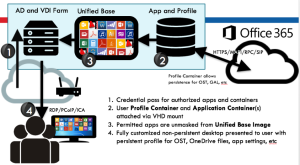Recently at Citrix Synergy, FSLogix announced a new feature code named Project Flux. Project Flux is a much needed and awaited feature in the non-persistent virtual desktop world. As applications move to cloud based infrastructures like Office 365 and the distance between client and server infrastructure grows, applications can suffer from poor performance issues. Things have been done to try and band aid this issue by redirecting folders to local file shares such as Application Data or just redirecting the caching portion of the application in applications such as Outlook or Lotus Notes. The problem with redirecting Application Data or just the caching portion of the application is we aren’t really solving the problem. The application can and will suffer from poor performance. I say can and will because at smaller scale things may seem ok, but what happens when you try to scale? The problem comes back or things get worse when another piece of infrastructure, like a file server, becomes overloaded during peak usage times of the day. So how does FSLogix solve this problem? With Project Flux!
FSLogix Process Overview:
What is Project Flux?
Project Flux isn’t necessarily a new concept in the FSLogix architecture. If you are already using FSLogix Profile Containers (launched at Citrix Synergy 2015), then you are already benefiting from what Project Flux can do for you. Project Flux allows you to just get the Data Container component of FSLogix and benefit from the goodness of their data container technology. This is great because if you already have a User Environment Management (UEM) or Profile Management solution, you can just get the Project Flux piece from FSLogix and use that with your existing solution. No need to rip and replace your current solution with the entire FSLogix solution. If you don’t have an existing solution, then you can get the entire FSLogix solution that includes the Project Flux feature set along with Profile and Application Containers.
The official name from Citrix Synergy for Project Flux is FSLogix Office 365 Container for Citrix. Now Project Flux isn’t only for Office 365 and/or Citrix solutions, this is just one use case example. Project Flux can be used with other desktop virtualization solutions, physical desktops, non Office 365 applications, etc. What Project Flux allows you to do is make non persistent virtual desktops a reality and give that local like experience back to your user base for applications like Outlook in Office 365. With Project Flux no more having to do workarounds that don’t scale and/or make the issue worse when moving to solutions like Outlook in Office 365. No more having to turn off indexing in virtual desktops allow users to search without the overhead caused in the past with non-persistent virtual desktops. No more having to figure out how to best configure Outlook Cached Exchange Mode when moving to Office 365.
With FSLogix Project Flux data containers are operating at a block level and mounting a VHD/VHDX for each user providing much more scalability and performance than at a file level with redirected folders or redirecting just the application caching piece to a file share. The data container is loaded in-guest when the users first access the application. When it comes to accessing data, accessing the data at a block level is much more efficient and scalable than at the file level. The issue with accessing the data at a file level is the file server becomes a bottleneck because Windows must open each file and file opens are handled synchronously causing a file server to quickly become overloaded especially with large files such as the Outlook .OST file. Just think of what can happen when multiple users open Outlook with redirected .OST files at the start of the day. Those .OST files being accessed can cause delays which then can cause user experience issues and lots of support calls. The benefit of FSLogix Project Flux data containers is the files are encapsulated within the data container along with all file operations. This is handled at a lower level bypassing having to open each file and making your file server more scalable.
FSLogix Project Flux can be used with applications such as Outlook, OneDrive, and Skype for Business in Office 365 by putting the caching components/%LOCALAPPDATA% to be placed in the data container. Having large file support for .OST, .PST, .PAB, etc in the data container. Reclaim your network and server capacity by seamlessly working existing infrastructure because network traffic is reduced and server traffic is increased with Project Flux.
Where’s the Proof?
In part one of this post you were introduced to FSLogix Project Flux. Just introducing/telling you about is not enough! How about seeing proof? Stay tuned because seeing is believing. In part two of this series scalability test info and results will be shown along with a demo/interview with FSLogix’s own David Young discussing the new Project Flux feature set. In the meantime, checkout our Frontline Chatter Podcast episode – A catchup with Kevin Goodman, CEO of FSLogix all about Synergy and Flux and the FSLogix blog post – FSLogix Logon Improvement Metrics from uberAgent.
Here’s a sneak peak of the performance of FSLogix compared to traditional profiles.
Stay tuned for more!
Jarian








Leave a reply